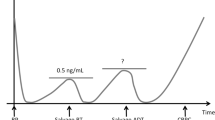Abstract
Background
This study aimed to investigate the efficacy of docetaxel in castration-resistant prostate cancer (CRPC) patients with intraductal carcinoma of the prostate (IDC-P).
Patients and methods
We retrospectively identified 79 CRPC patients with distant metastasis at initial diagnosis from June 2002 to January 2014. All patients received initial androgen deprivation therapy and 46 received docetaxel chemotherapy after progressing to CRPC. The primary outcome of interest was cancer-specific survival (CSS) from the time of CRPC diagnosis. The Cox regression model was used to confirm whether IDC-P and docetaxel would act as independent factors for prognosis.
Results
IDC-P was found in 62 of 79 patients. The median CSS in the IDC-P-present group was 18.2 versus 45.6 months in the IDC-P-absent group (HR 2.67; 95% CI 1.18 to 6.06; P = 0.019). Docetaxel was administered to 36 patients with IDC-P and 10 patients without IDC-P, with a median CSS of 20.5 versus 53.2 months, respectively (HR 2.98; 95% CI 1.02 to 8.64; P = 0.044). Multivariate analysis demonstrated that the presence of IDC-P and docetaxel were independent prognostic factors for CSS (P = 0.026 and 0.005, respectively) and overall survival (OS) (P = 0.029 and 0.001, respectively).
Conclusion
The presence of IDC-P is an independent prognostic factor in CRPC patients with distant metastases and IDC-P in needle biopsies at the time of initial diagnosis. Docetaxel may prolong CSS and OS in CRPC patients with distant metastases and IDC-P in needle biopsies at the time of initial diagnosis.


Similar content being viewed by others
References
Kovi J, Jackson MA, Heshmat MY (1985) Ductal spread in prostatic carcinoma. Cancer 56:1566–1573
McNeal JE, Yemoto CE (1996) Spread of adenocarcinoma within prostatic ducts and acini: morphologic and clinical correlations. Am J Surg Pathol 20(7):802–814
Guo CC, Epstein JI (2006) Intraductal carcinoma of the prostate on needle biopsy: histologic features and clinical significance. Mod Pathol 19:1528–1535
Kimura K, Tsuzuki T, Kato M et al (2014) Prognostic value of intraductal carcinoma of the prostate in radical prostatectomy specimens. Prostate 74:680–687
Kato M, Tsuzuki T, Kimura K et al (2016) The presence of intraductal carcinoma of the prostate in needle biopsy is a significant prognostic factor for prostate cancer patients with distant metastasis at initial presentation. Mod Pathol 29:166–173
Zhao T, Liao B, Yao J et al (2015) Is there any prognostic impact of intraductal carcinoma of prostate in initial diagnosed aggressively metastatic prostate cancer? Prostate 75:225–232
Morais CL, Han JS, Gordetsky J et al (2015) Utility of PTEN and ERG immunostaining for distinguishing high-grade PIN from intraductal carcinoma of the prostate on needle biopsy. Am J Surg Pathol 39:169–178
Risbridger GP, Taylor RA, Clouston D et al (2015) Patient derived xenografts reveal that intraductal carcinoma of the prostate is a prominent pathology in BRCA2 mutation carriers with prostate cancer and correlates with poor prognosis. Eur Urol 67:496–503
Lindberg J, Kristiansen A, Wiklund P et al (2015) Tracking the origin of metastatic prostate cancer. Eur Urol 67:819–822
Epstein JI, Egevad L, Amin M et al (2016) The 2016 International Society of Urological Pathology (ISUP) consensus conference on Gleason grading of prostatic carcinoma. Am J Surg Pathol 40:244–252
Humphrey PA, Moch H, Cubilla AL et al (2016) The 2016 WHO classification of tumours of the urinary system and male genital organs-part B: prostate and bladder tumours. Eur Urol 70:106–119
Tannock IF, de Wit R, Berry WR et al (2004) Docetaxel plus prednisone or mitoxantrone plus prednisone for advanced prostate cancer. N Engl J Med 351:1502–1512
Petrylak DP, Tangen CM, Hussain MH et al (2004) Docetaxel and estramustine compared with mitoxantrone and prednisone for advanced refractory prostate cancer. N Engl J Med 351:1513–1520
Sobin LH, Gospodarowicz MK, Wittekind C (2009) TNM classification of malignant tumors, 7th edn. Wiley, Oxford
Scher HI, Halabi S, Tannock I et al (2008) Design and end points of clinical trials for patients with progressive prostate cancer and castrate levels of testosterone: recommendations of the Prostate Cancer Clinical Trials Working Group. J Clin Oncol 26:1148–1159
Heidenreich A, Bastian PJ, Bellmunt J et al (2014) EAU guidelines on prostate cancer. Part II: treatment of advanced, relapsing, and castration-resistant prostate cancer. Eur Urol 65:467–479
Tsuzuki T (2015) Intraductal carcinoma of the prostate: a comprehensive and updated review. Int J Urol 22:140–145
Chen Z, Chen N, Shen P et al (2015) The presence and clinical implication of intraductal carcinoma of prostate in metastatic castration resistant prostate cancer. Prostate 75:1247–1254
Naito S, Tsukamoto T, Koga H et al (2008) Docetaxel plus prednisolone for the treatment of metastatic hormone-refractory prostate cancer: a multicenter phase II Trial in Japan. Jpn J Clin Oncol 38(5):365–372
Sweeney CJ, Chen YH, Carducci M et al (2015) Chemohormonal therapy in metastatic hormone-sensitive prostate cancer. N Engl J Med 373:737–746
Epstein JI, Zelefsky MJ, Sjoberg DD et al (2016) A contemporary prostate cancer grading system: a validated alternative to the Gleason score. Eur Urol 69:428–435
Acknowledgements
We would like to thank Yushi Yamauchi, Department of Urology, Japanese Red Cross Nagoya Daini Hospital, Nagoya, Japan; Yoshie Moriya, Department of Urology, Komaki City Hospital, Komaki, Aichi, Japan; Yuta Sano, Department of Urology, Chukyo Hospital, Nagoya, Japan, for their help to investigate the present study.
Author information
Authors and Affiliations
Corresponding authors
Ethics declarations
Conflict of interest
The authors have no conflict of interest to declare.
About this article
Cite this article
Yamamoto, A., Kato, M., Matsui, H. et al. Efficacy of docetaxel in castration-resistant prostate cancer patients with intraductal carcinoma of the prostate. Int J Clin Oncol 23, 584–590 (2018). https://doi.org/10.1007/s10147-017-1235-6
Received:
Accepted:
Published:
Issue Date:
DOI: https://doi.org/10.1007/s10147-017-1235-6




